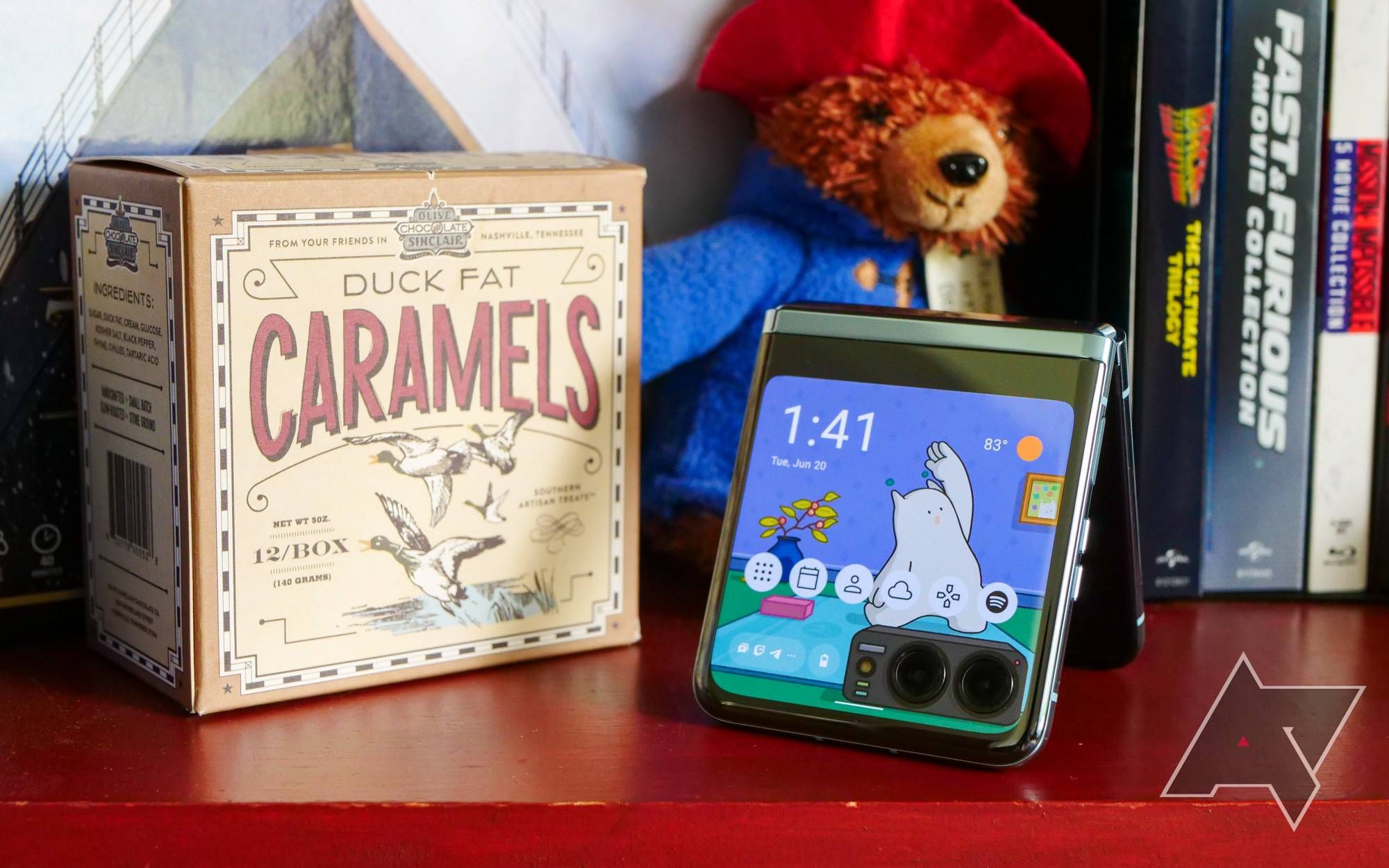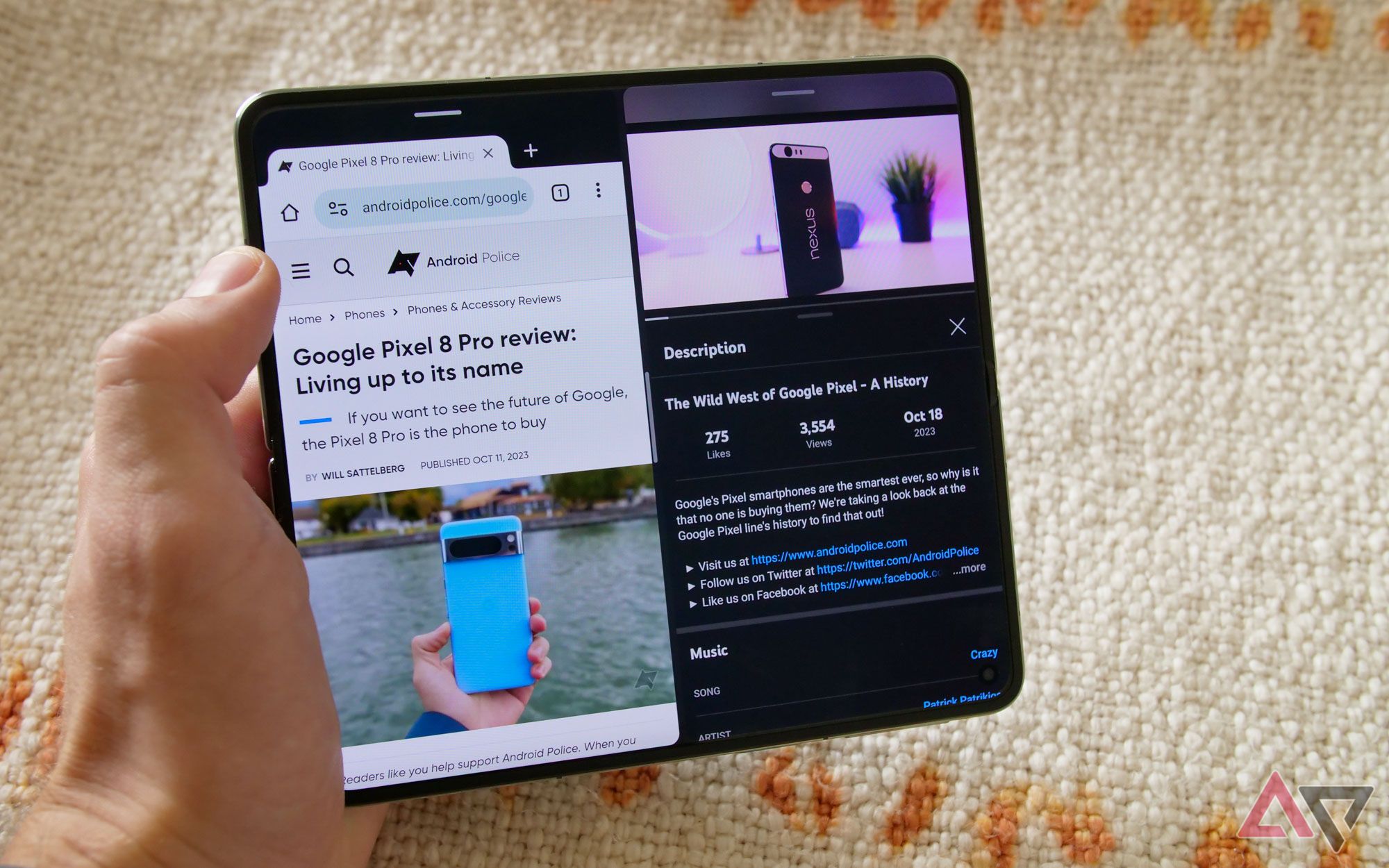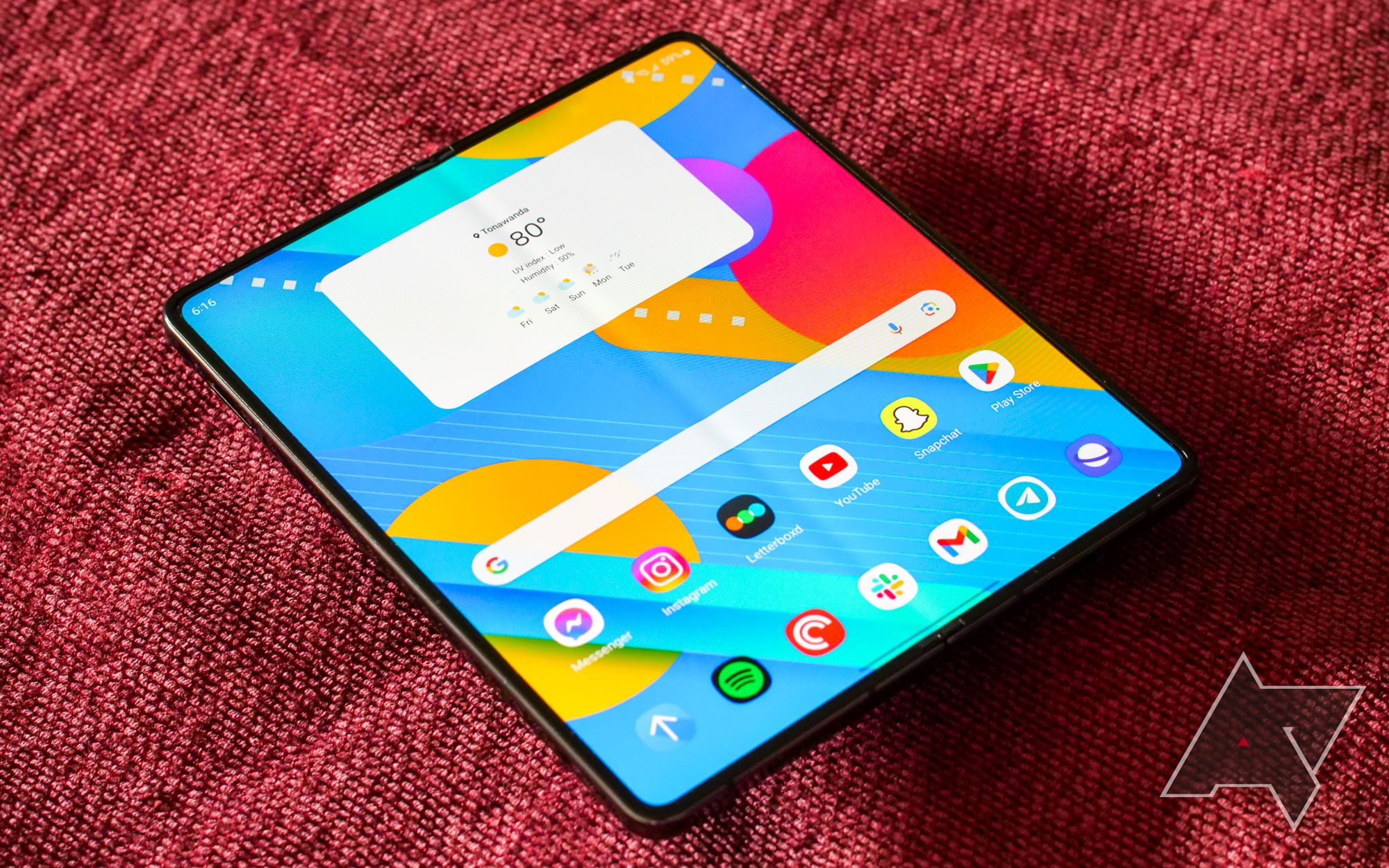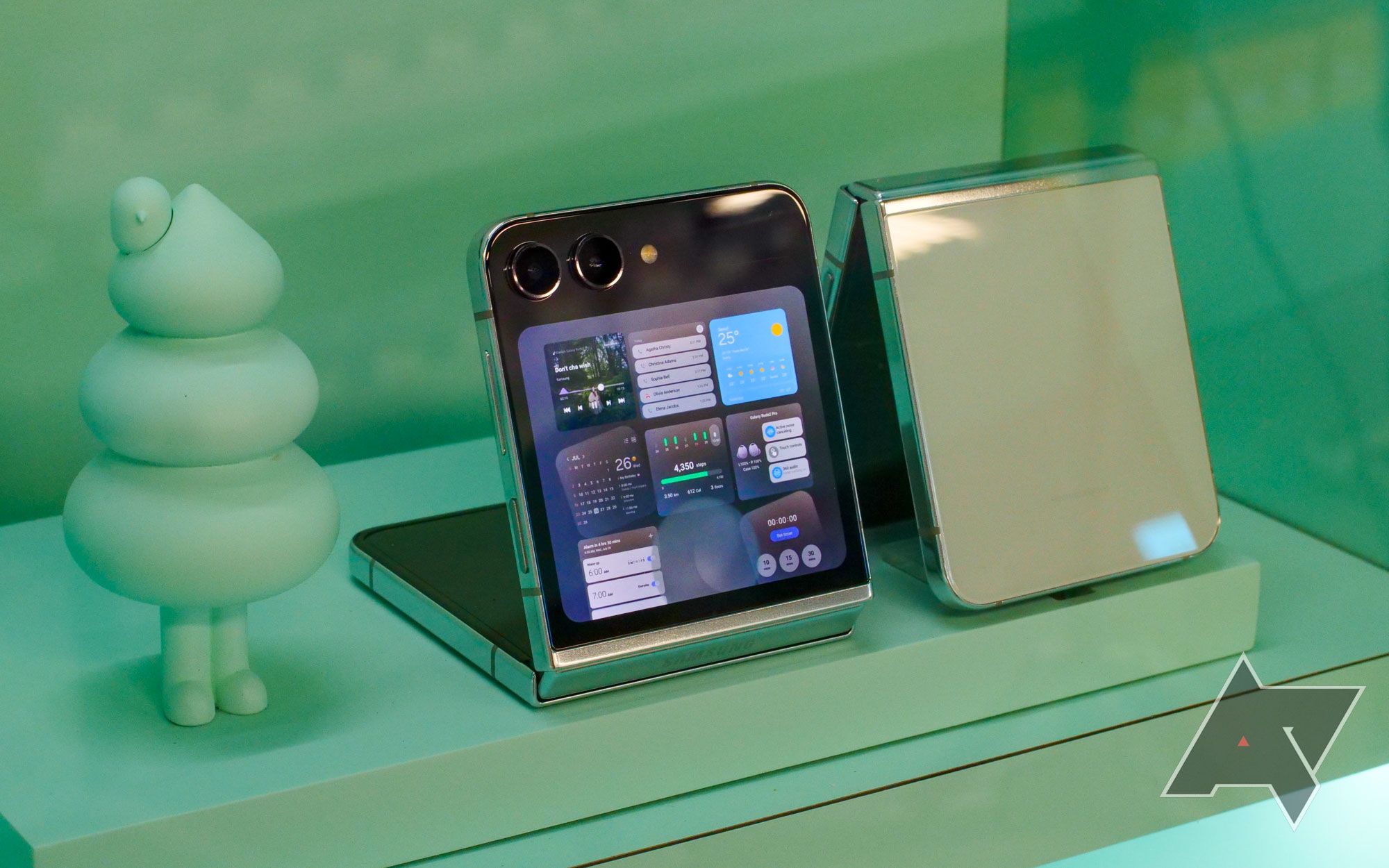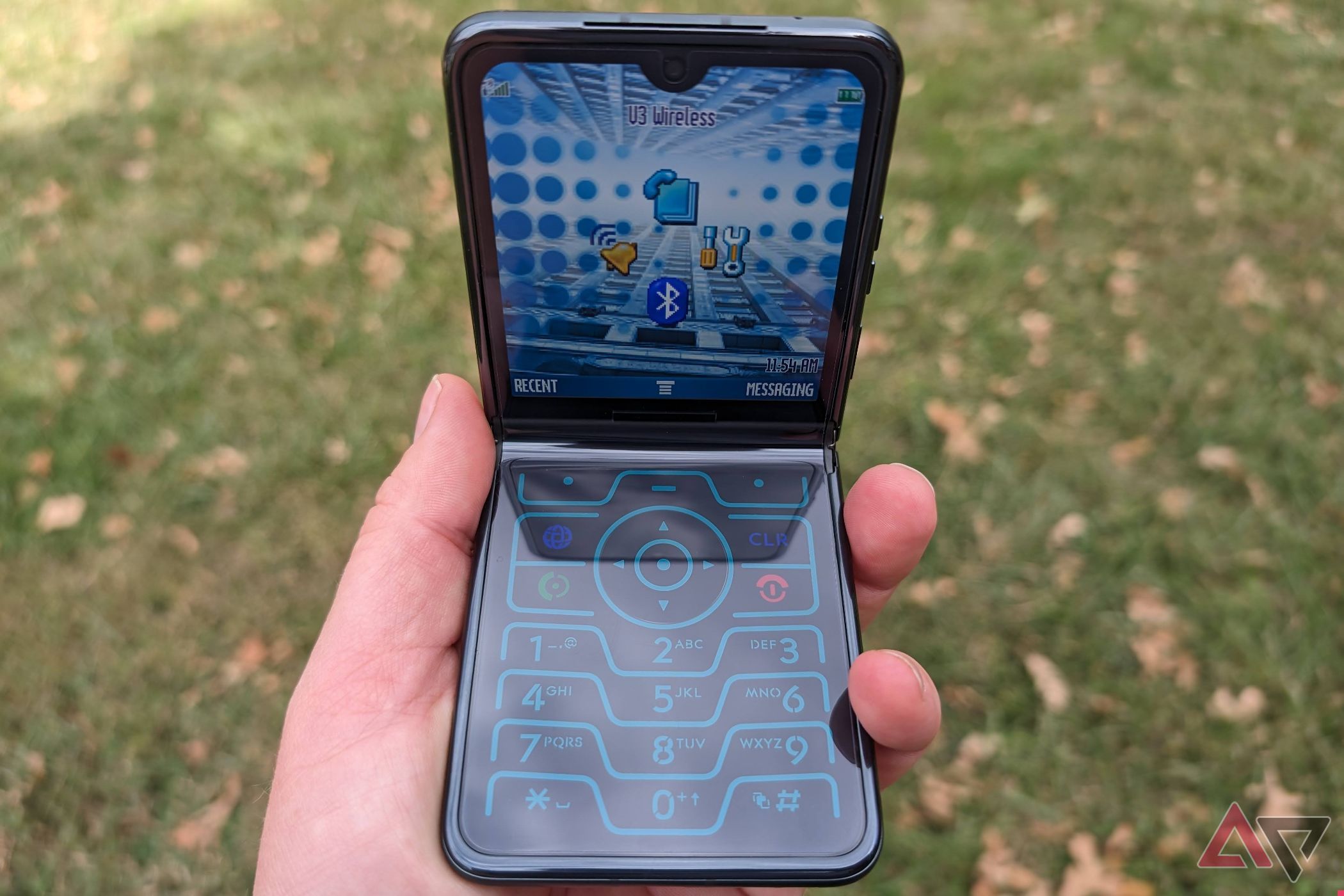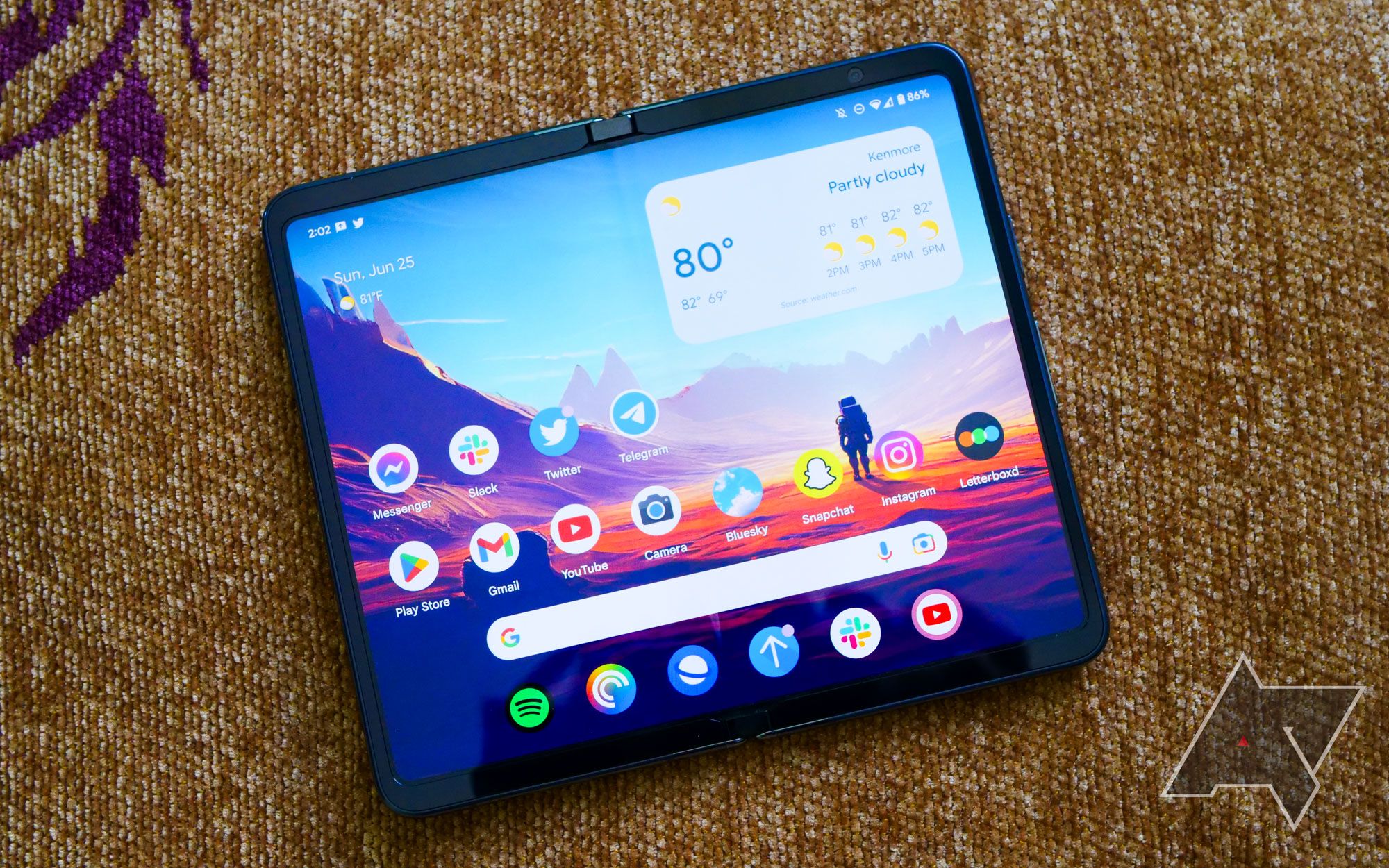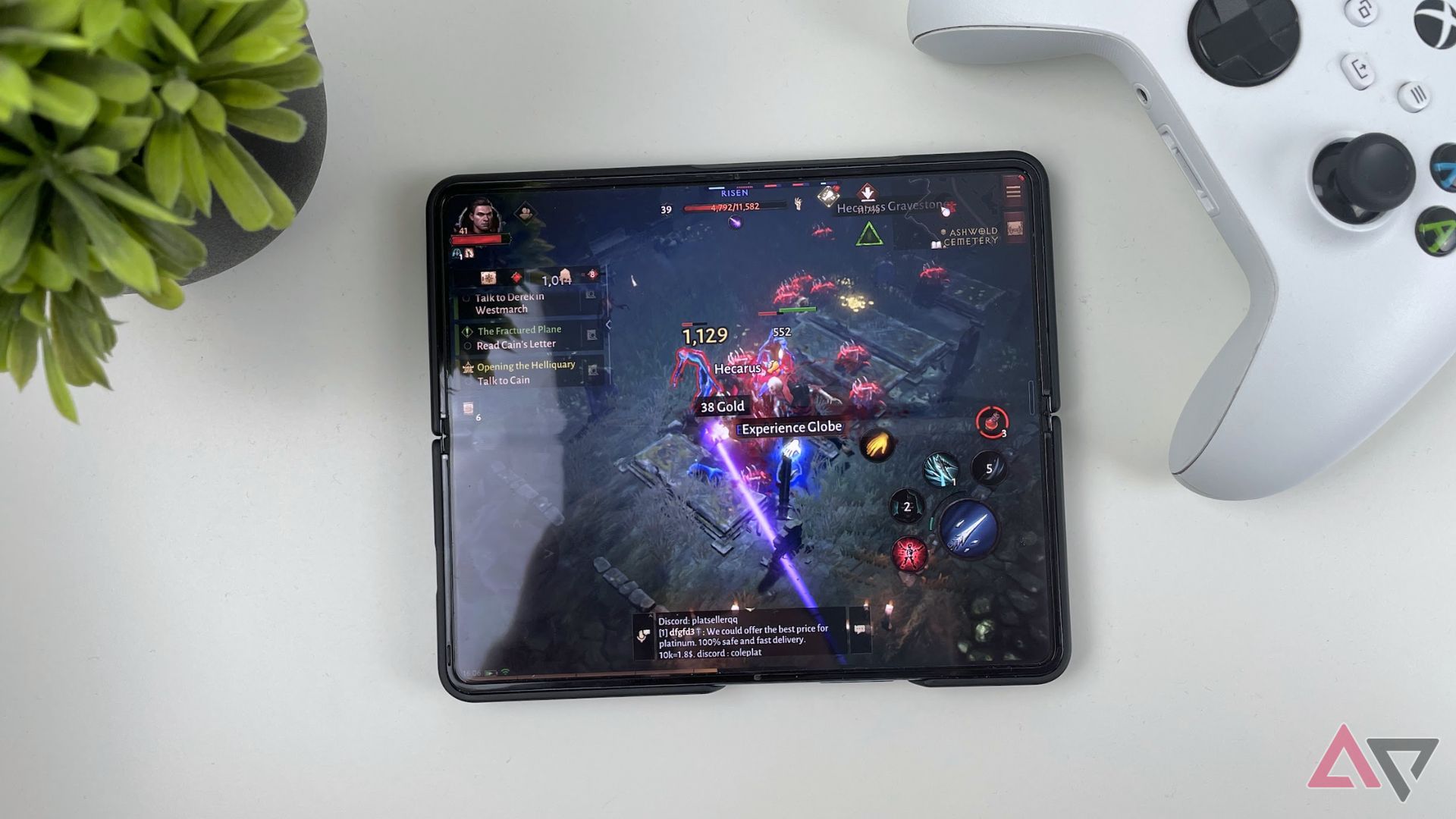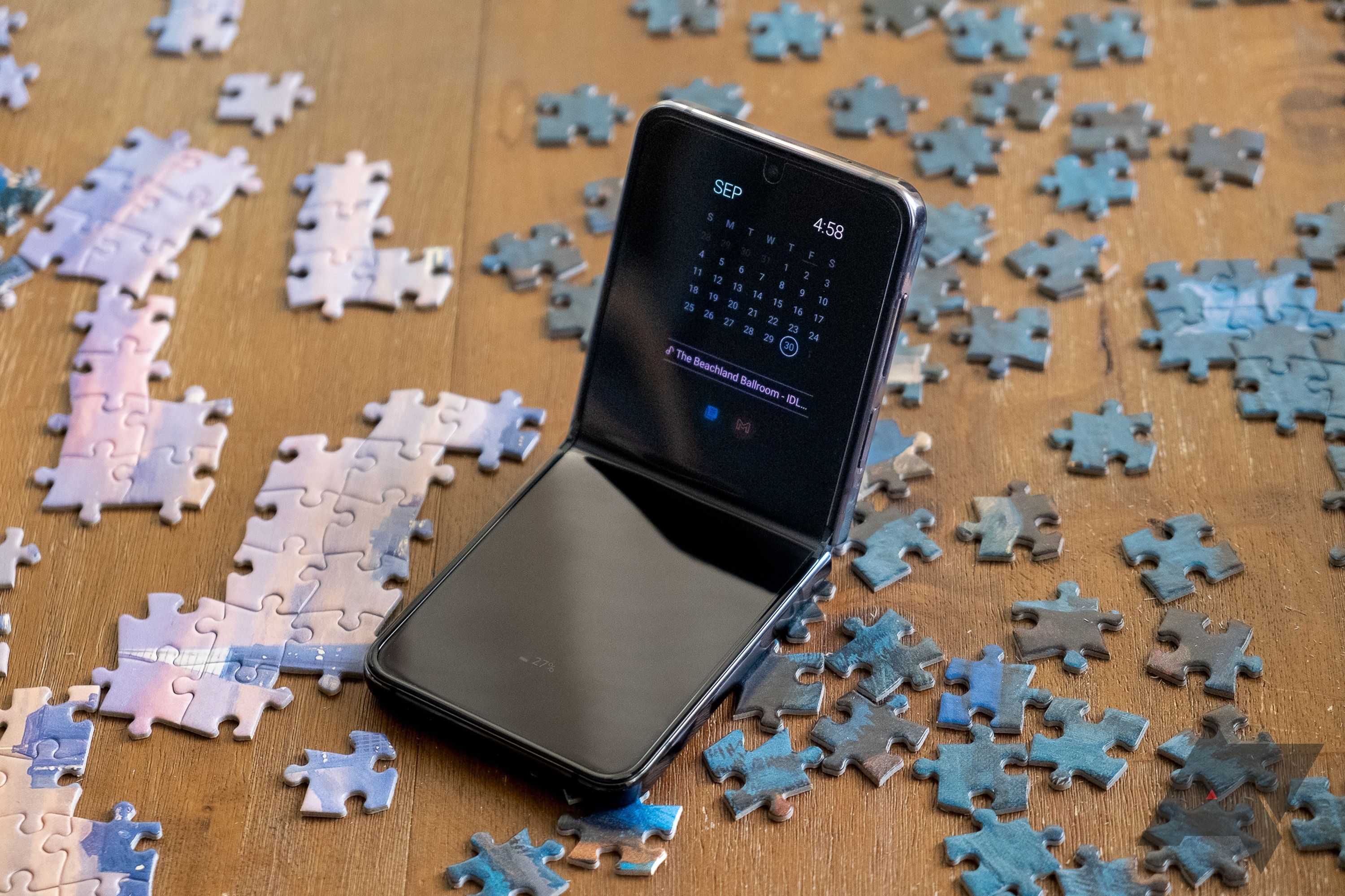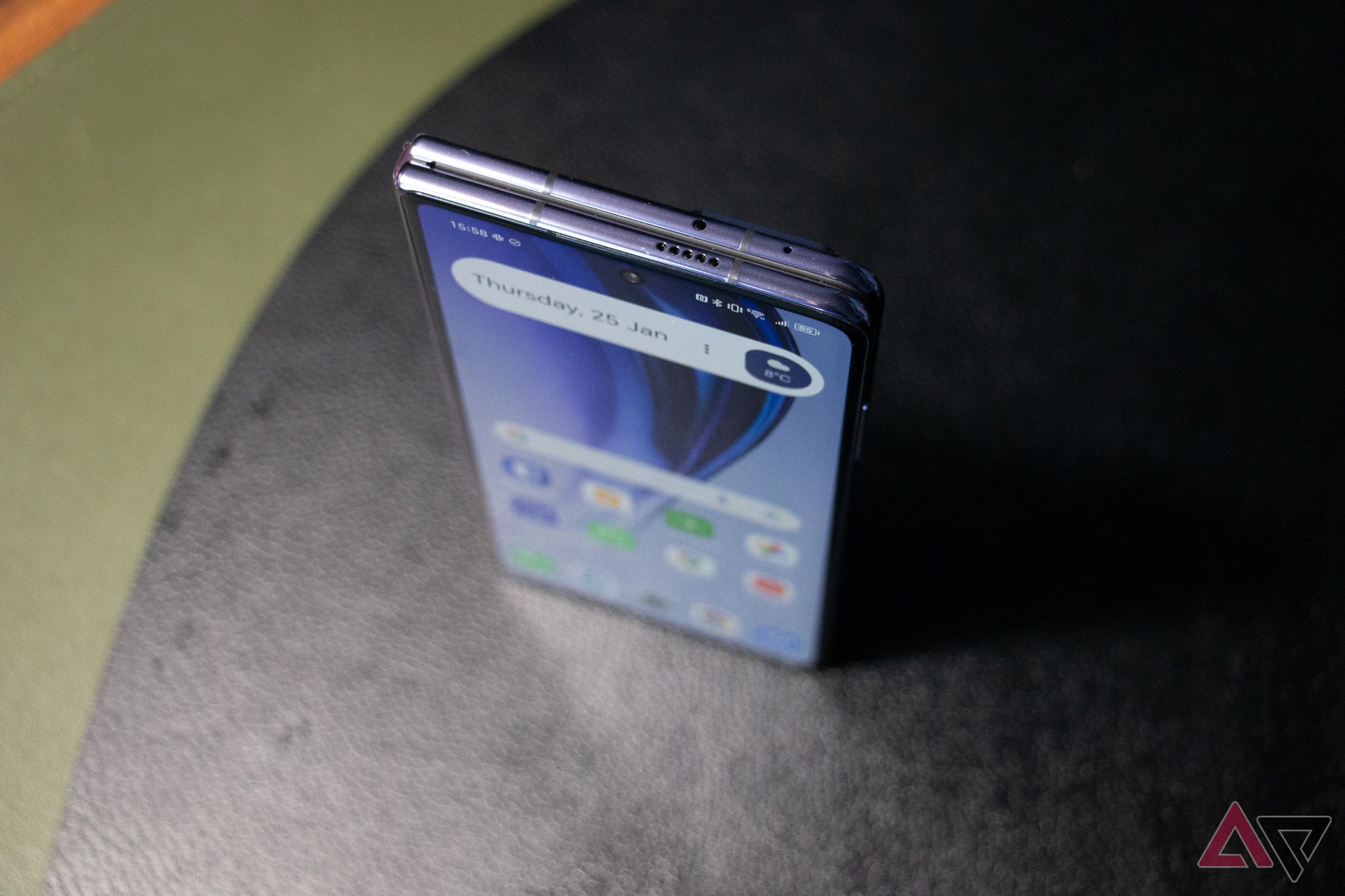It’s never been a more exciting time for foldable and flippable phones. Fun and powerful new designs have come into their own over the past few years, moving from pricey novelties to some of the best Android flagship phones, and today we have a wealth of options to choose from, with something for everyone.
While it was Samsung that really kicked off this trend in 2019 with the tablet-style Galaxy Z Fold, Motorola was also quick to jump into the game, delighting us only a few months later with a re-imagining of its iconic Razr V3 for the smartphone generation. Suddenly, we were off to the races with two exciting form factors: vertically foldable phones that lent themselves to folks who wanted pocketable tablets for serious productivity and flip phones that resurrected the whimsical and compact designs of a bygone era.
Samsung quickly followed Motorola’s lead with its Galaxy Z Flip series, bringing a more modern and refined design to the flip phone that Motorola later adopted for its own 2023 Razr lineup. Meanwhile, the dynamic duo of Samsung and Motorola were joined by surprising new entries from Google and OnePlus, and today we’re finally starting to see sub-$1,000 flip phones enter the arena as viable alternatives to flagships like the Pixel 8.
Top foldable phones
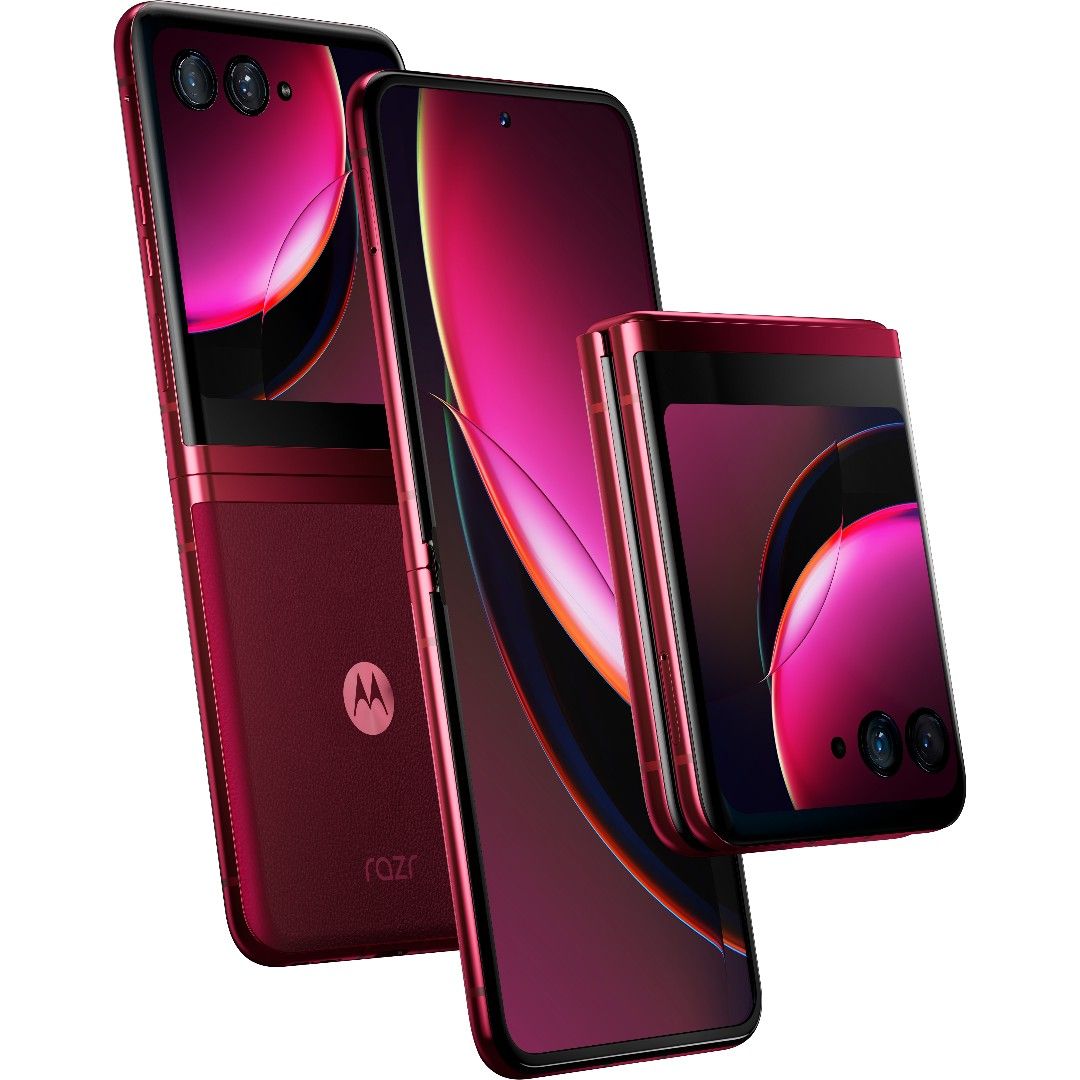
Motorola Razr+ (2023)
Motorola’s foldable returns in style
The Motorola Razr+ puts the fun back into a smartphone. With a 3.6-inch, 1:1 display on the outside of the device, it has never been easier to manage notifications, texts, navigation, and so much more. And when you unfold the phone, a more standard 6.9″ display is revealed. The Razr+ is a surprising rebound after the first couple of generations failed to get any traction.
- Big front display
- All-day battery life
- Plenty of performance
- Cameras aren’t particularly good
- Some limitations on the front screen
- Worse software support than Samsung’s
While it’s been out for almost a year now, the Motorola Razr+ is one of our favorite foldables ever and easily makes a case for being better than its Samsung-made competition. It does resemble the now highly refined Z Flip series but offers a couple of key improvements. For one, the entire chassis is slimmed down, allowing the whole phone to flip closed into an entirely flat form while staying thin and light in your pocket. Its rounded edges also feel excellent to the touch. Performance is also great, with the Snapdragon 8+ Gen 1 balancing speed and efficiency for all-day battery life.
But while Motorola hasn’t had the same number of generations to refine its own foldables, it clearly learned from what Samsung’s spent so long doing. Chiefly, its full-size outer display makes it one of the most useful smartphones in existence and takes excellent advantage of the form factor. The hinge also exudes durability, with just the right amount of click-into-place feeling, and a relatively well-hidden inner display crease.
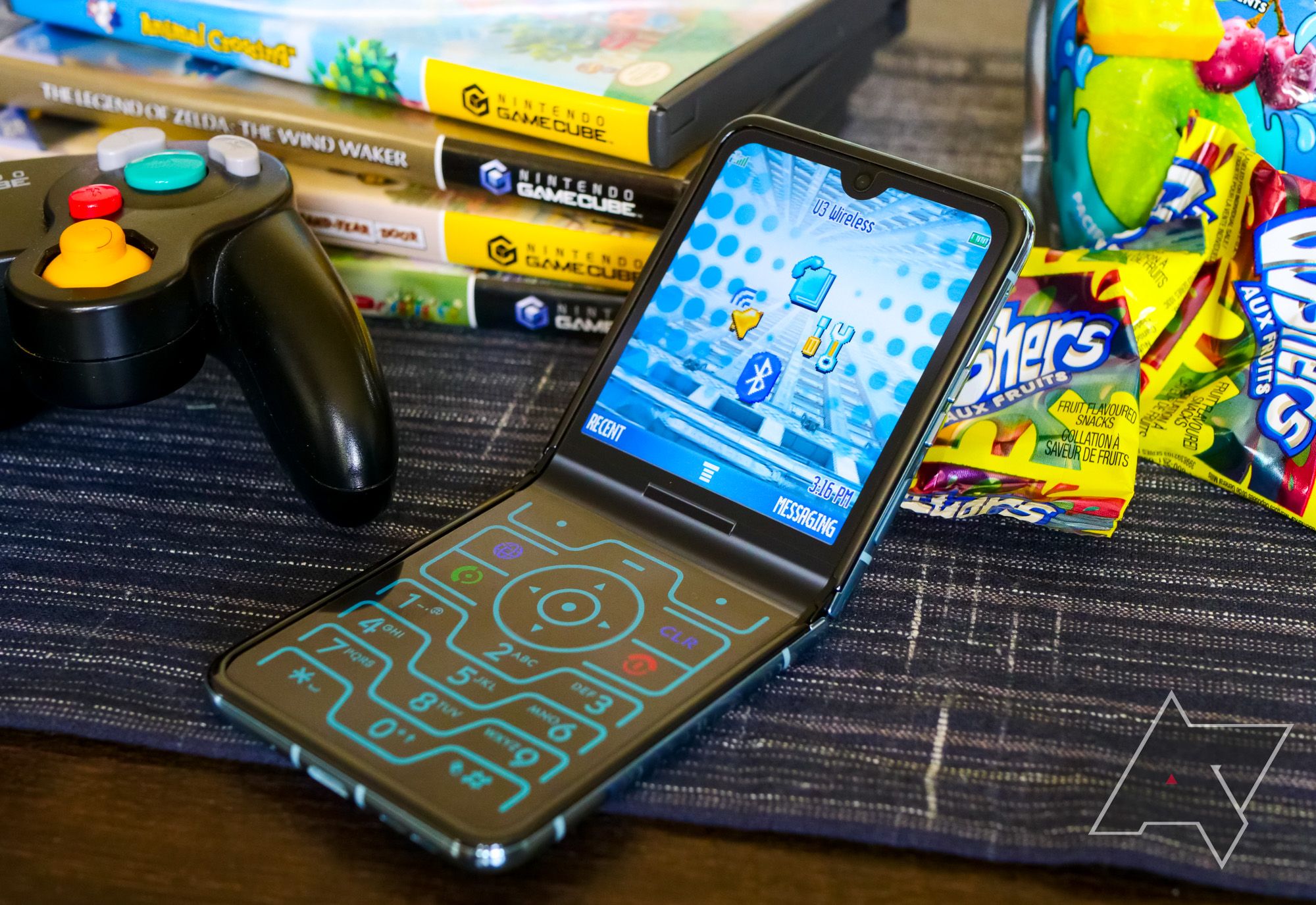
Motorola Razr+ review: My new favorite foldable
The GOAT of flip phones can finally reclaim its throne
Of course, it’s not a perfect phone. The cameras, unsurprisingly, suffer thanks to the limited sensor space and Motorola’s subpar image processing. It also picks up plenty of smudges on the front display, which might leave you cleaning your fingerprints off constantly. Plus, its successor is due soon, and that’s bound to bring along some upgrades. But if you’re after a great foldable phone, you can’t do better than the Motorola Razr+, especially now that it’s mostly available at discounted prices.
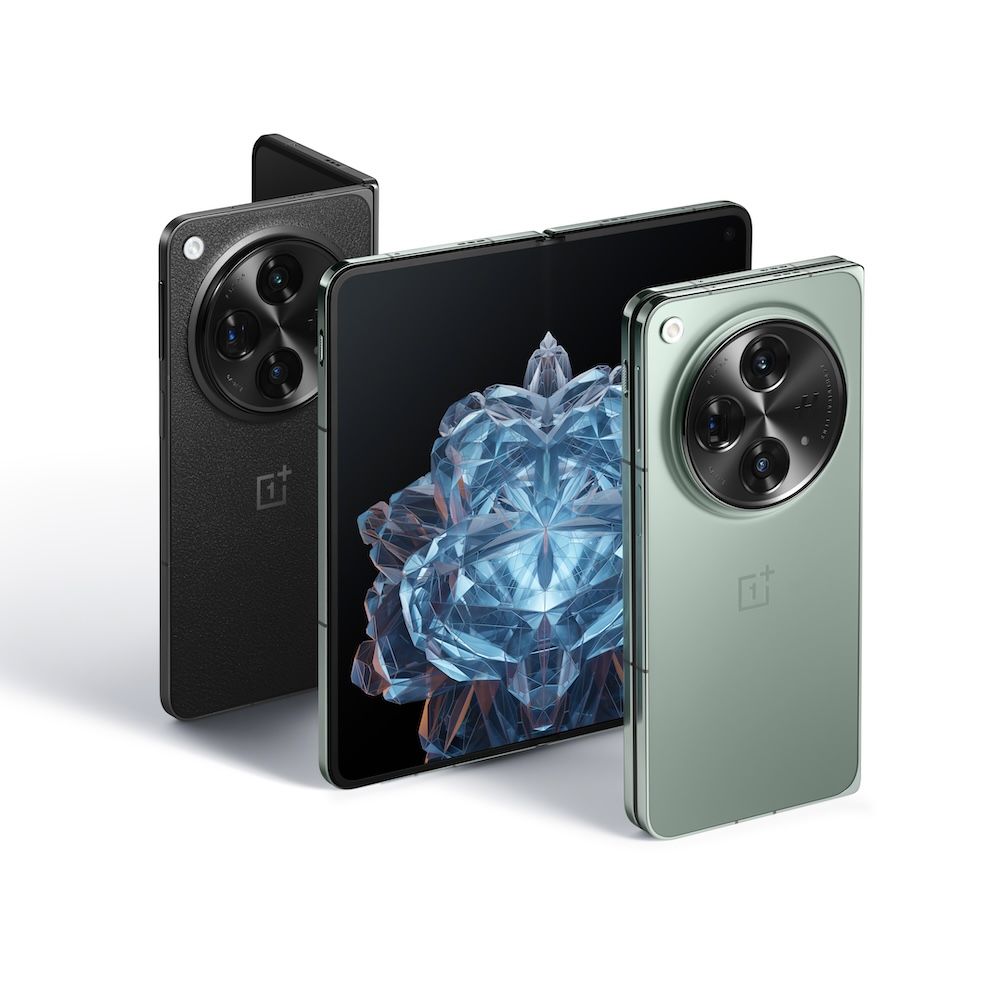
OnePlus Open
An impressive first attempt
Despite being the company’s first foldable, the OnePlus Open gives the competition a run for its money with an impressive debut. It boasts excellent build quality with the internals expected of a flagship phone, plus it offers innovative software features. And, unlike its rivals, the OnePlus Open comes with a charger and a case in the box.
- Premium build quality
- Innovative multitasking features
- Great cameras
- Less-than-stellar OxygenOS UI
- No wireless charging
Called the Oppo Find N3 in international markets (and sold with different software and colors), the OnePlus Open rightly receives praise for competing with, and in many ways besting, its Galaxy Z Fold-branded competition. Not unlike the Razr+, OnePlus’s very first foldable took notes on Samsung’s design and implementation and made a great argument for doing it better. A far cry from early foldables, it looks and feels extremely premium, with a dependable hinge, quality materials, and barely noticeable crease.
It doesn’t just feel or look great; it also packs some pretty impressive specs. Under the hood, the OnePlus Open has Qualcomm’s Snapdragon 8 Gen 2 chip, which ensures excellent performance, and also contributes heavily to the impressive all-day battery life. Coupled with 16GB of RAM and 512GB of storage, it’s a blazing-fast device.
Speaking of performance, it’s a multitasking powerhouse. We were pleasantly surprised at some of the novel software aspects geared toward getting things done from multiple angles. Letting multiple apps share the screen (and making that easy to configure and arrange) is one of a few big wins for OnePlus here, even in the face of some quibbles we still have with OxygenOS. It’s not exactly bad, but it clearly isn’t as polished as the skins from Google or Samsung.
OnePlus’s pairing with Hasselblad makes for a great camera experience, which isn’t surprising considering Hasselblad’s reputation. It’s not quite perfect, as on OnePlus’s side there’s still the occasional image processing quirk. But in light of the uninspiring and oversaturated cameras on the Z Fold lineup, photography’s one more arena where the Open scores a win.
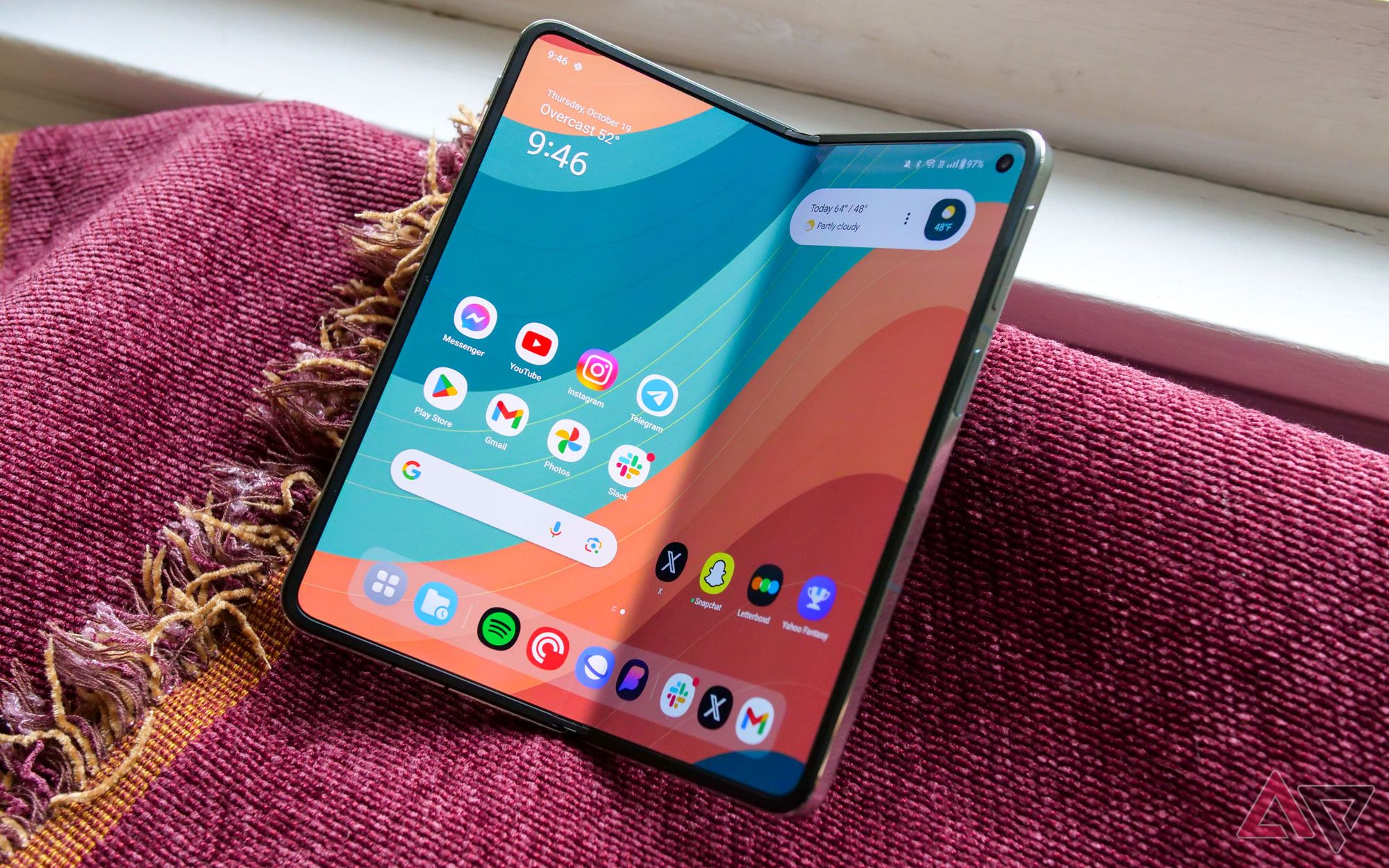
OnePlus Open review: What every foldable should be
Leave it to OnePlus to supply the competition Samsung so desperately needs
The OnePlus Open still has its shortcomings. One of those aforementioned software quibbles is with the delayed notifications that apparently result from some aggressive optimizations. Also, its lack of wireless charging can be considered a deal-breaker for some, but it makes up for that with impressive battery life and support for 67W fast charging, which trumps what its rivals offer. On top of that, there is a full-speed charger in the box, a rarity when it comes to premium smartphones, foldable or not. It even comes with a case, but there are plenty of great third-party Open cases, too.
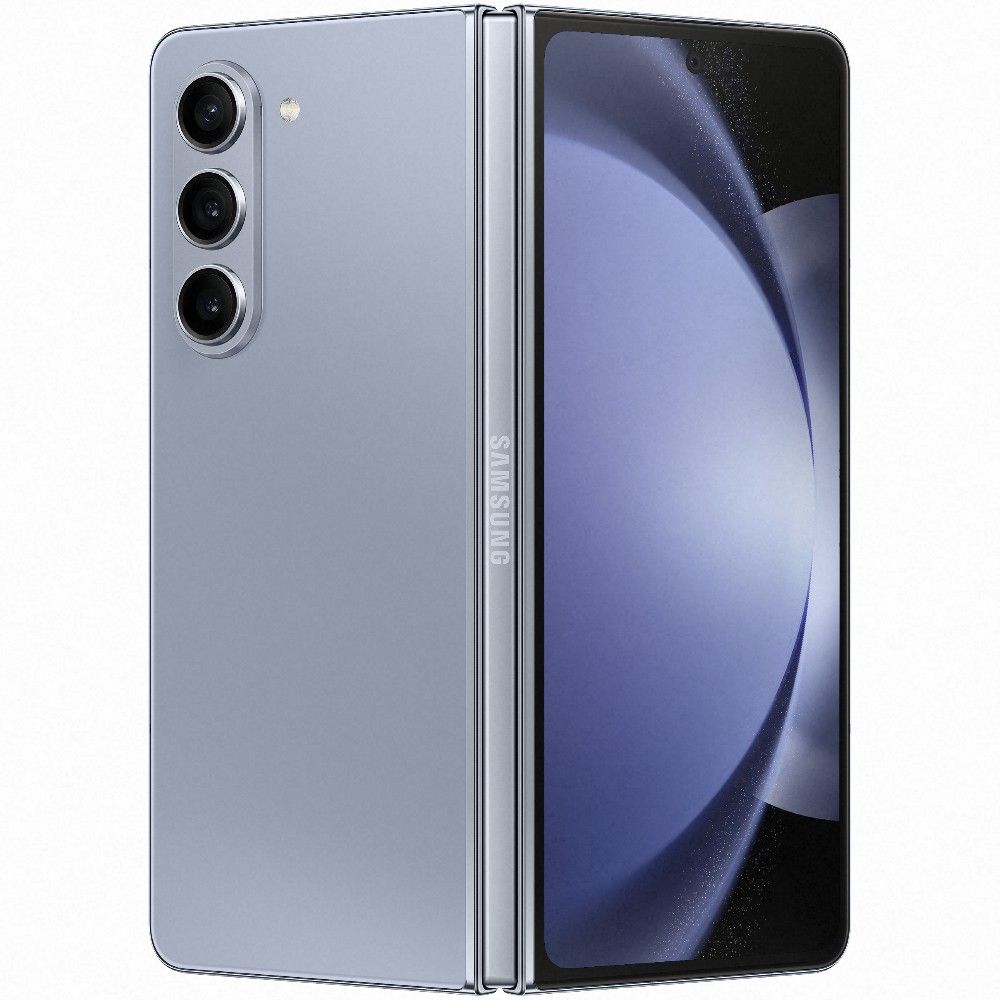
Samsung Galaxy Z Fold 5
Don’t fix what isn’t broken
The Galaxy Z Fold 5 picked up a new hinge and a thinner design that’s much easier to carry around for this generation. Its upgraded Snapdragon 8 Gen 2 CPU can keep up with any task, and you can expect the battery to get you through most of the day. The screens are still brilliant, and the same quad-camera setup is available.
- Good – if unpredictable – battery life
- Slimmed-down chassis finally feels pocket-friendly
- One UI’s foldable enhancements remain excellent
- Design feels a bit stale
- No tangible camera improvements over the Fold 4
- Limited to 25W charging
Samsung’s Z Fold 5 basically sets the standard for tablet-style foldables, even if some other options exceed that standard in a couple of ways. We found the 6.2-inch outer display perfectly usable, if a bit cramped when typing. Meanwhile, the 7.6-inch inner display is still one of the best in the business, with impressive clarity and brightness that result in perfect visual fidelity in any lighting. And, of course, the performance is there, with the overclocked Snapdragon 8 Gen 2 crunching numbers with the best of them.
Samsung didn’t make any huge design changes for this generation, but it did eliminate the gap between the two halves of the phone when folded. And while it’s not the most novel design in general, we love the refinements, since they clearly show the Z Fold 5’s maturity. Cameras have also gone unchanged, save for a new lens coating that should reduce lens flare. Unfortunately, that also means it retains the less-than-inspiring camera performance, which the competition noticeably beats in daily use.
Battery life is fine, but heavy use did induce some charge anxiety at the end of the day during our in-depth testing. That’d be a little less of a problem if a quick top-up would always do the job, but we’re still critical of the 25W peak charging rate. When the competition comes with better battery life and a 67W charger included, it’s hard to justify such slow refueling.
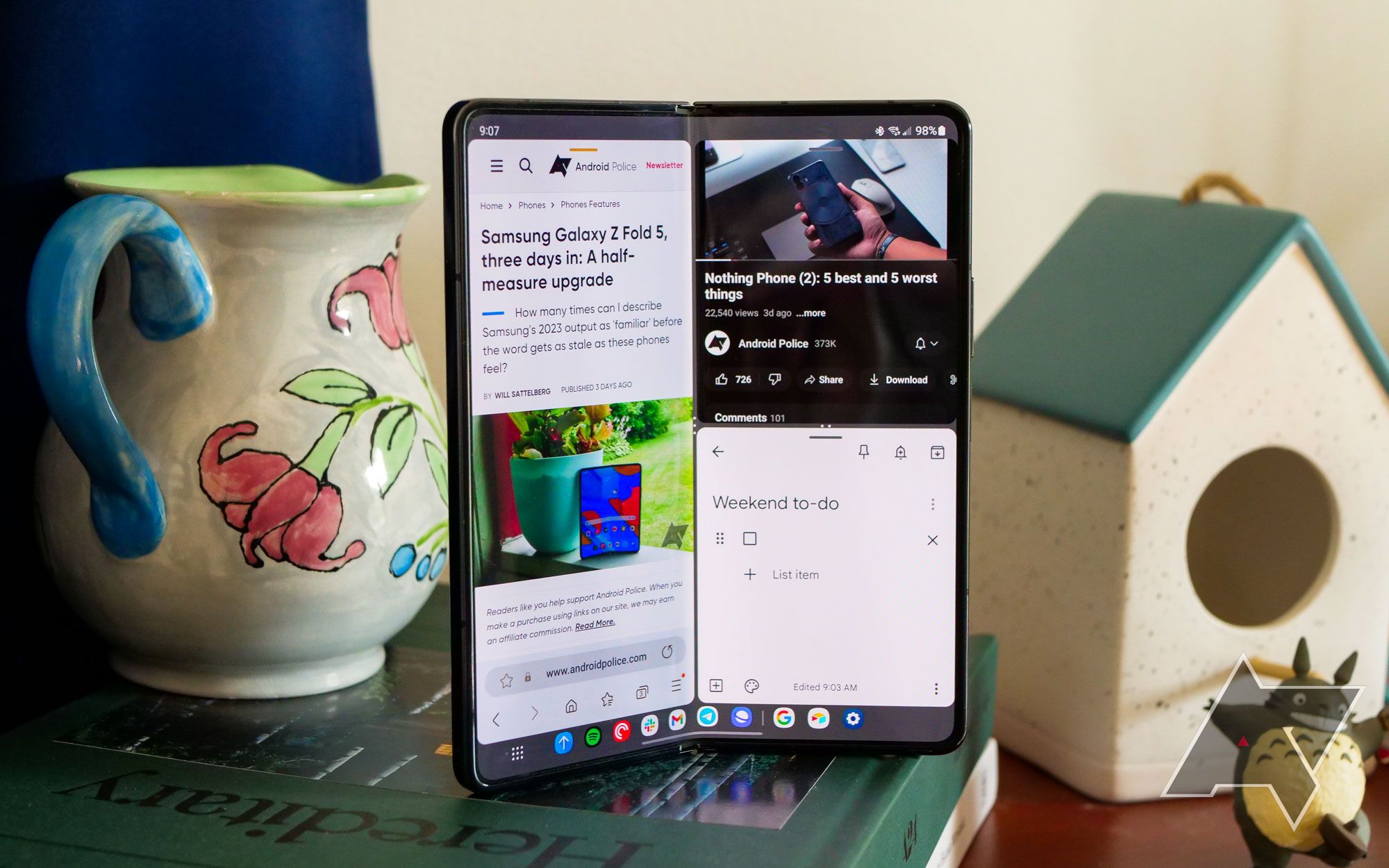
Samsung Galaxy Z Fold 5 review: Polished to a sheen
With more competition than ever before, Samsung chooses to coast
But this standard-bearer really shines in the software. Samsung’s mastery of Android for smartphones and tablets is on full display, with an intuitive layout that you can heavily alter to suit your needs. It is now updated with the same Galaxy AI features found on the Galaxy S24 series.
We had no problems with multitasking, from either a performance or software standpoint, although it’s a bit surprising One UI doesn’t have the same multi-app tools that foldable newcomers like OnePlus offer. With the Z Fold 6 expected to bring another year of incremental updates, the Z Fold 5 is still worth consideration, even more so if you can find it for a discount.
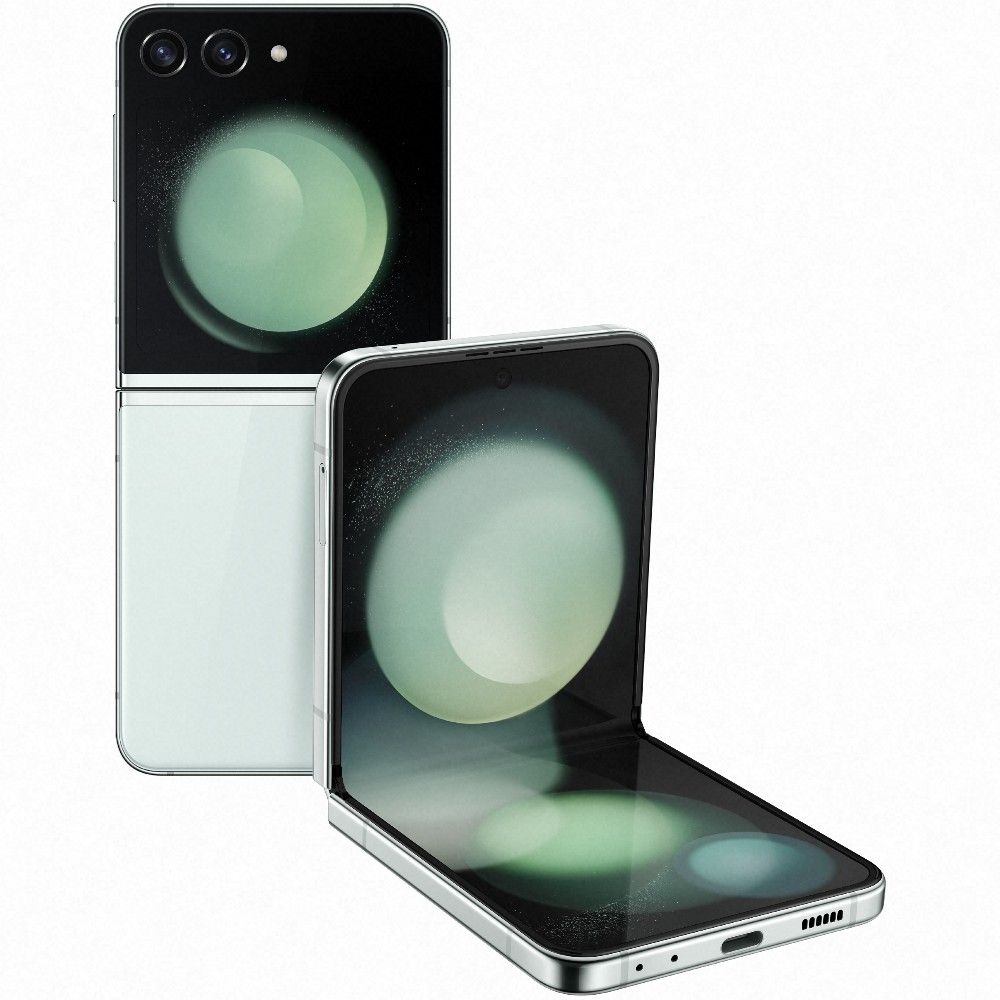
Samsung Galaxy Z Flip 5
What a wonderful fold
Those who prefer One UI over Motorola’s Android build should consider the Galaxy Flip 5. It has a new cover screen, a new processor, and a new hinge, plus you can pick it up in plenty of different colors to suit your style. Best part? Despite all the improvements, Samsung is asking for the same launch price as the Z Flip 4.
- New 3.4-inch cover screen
- Upgraded Snapdragon 8 Gen 2 CPU
- Same launch price as the Z Flip 4
- No upgrade to the cameras
While the Z Flip 5 only sees a couple of improvements compared to its predecessor, they’re relatively big ones that we really appreciate. The most noticeable is the full-size outer screen that, like the one on the Razr+, revolutionizes how you can use a flip phone. It’s clear and crisp, easily bright enough, and equipped with a host of useful software features and supported apps.
The other big upgrade is the new hinge, which eliminates the previously annoying gap and feels considerably more rugged during use and when unfolded. Like the Z Fold 5, the Flip feels more mature than ever and has come a long way from the fragile design of the early models. In some ways, it might be a little too refined, though, as the new fold-flat design and practically seamless outer edge made it a bit tough to open one-handed. We also wish Samsung had done a better job of hiding the crease.
The cameras are OK in terms of specs and performance, but the key here is how Samsung utilizes the form factor to deliver a novel and improved picture-taking experience. The ability to use the outer display as a full-size selfie viewfinder makes this one of the best phones for capturing your own beautiful face, and the app interactions and built-in stand that come into play when the Flip’s half-open are more testimony to how useful that exterior screen can be. As with the Fold, the Z Flip 5 also gets AI-powered camera modes for more flexibility.
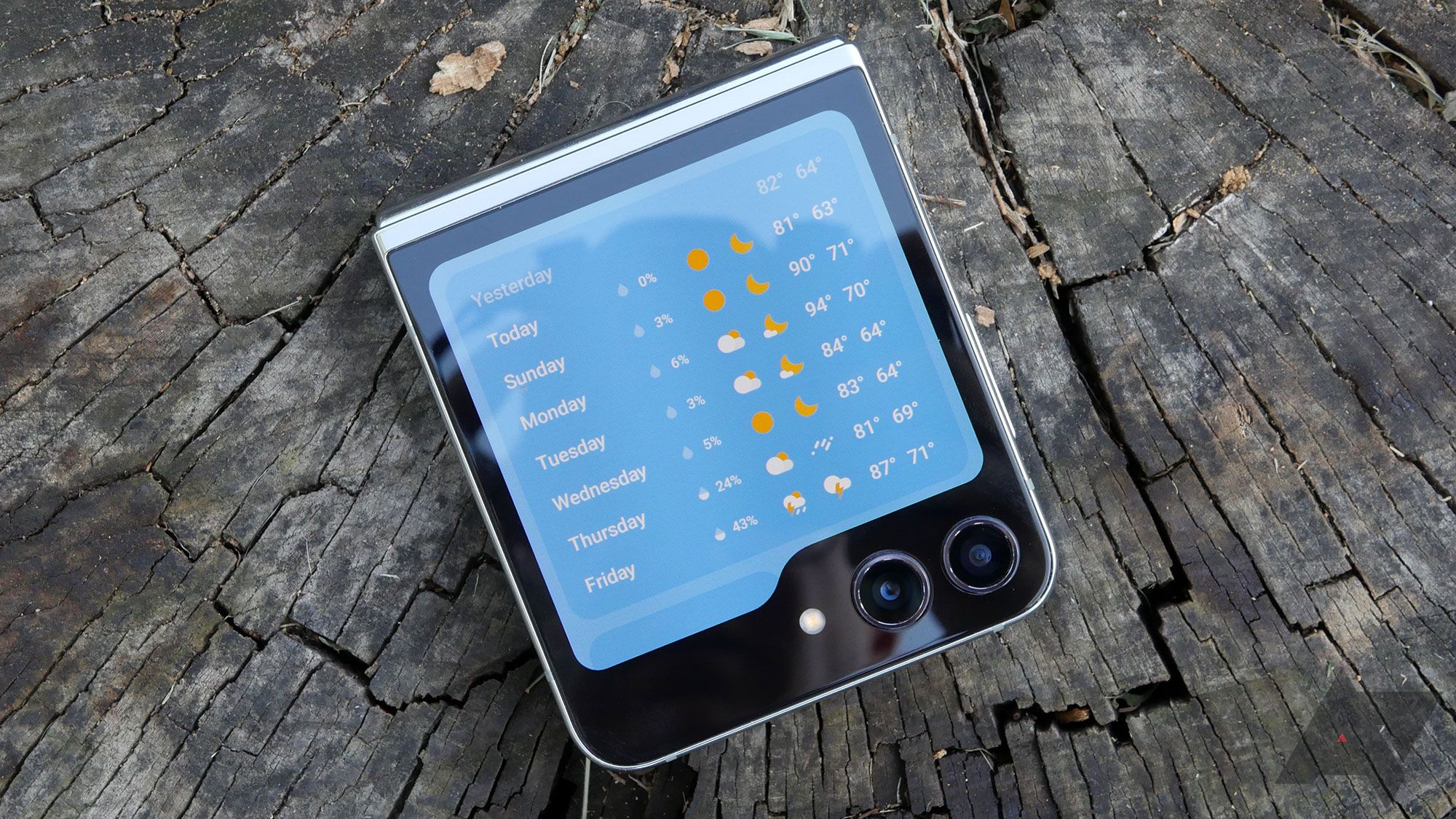
Samsung Galaxy Z Flip 5 review: Flex Window for the win
A slightly larger cover screen makes all the difference in the world
The performance is right in line with the Fold, and battery life beats the Z Flip 4 due largely to the drastically more efficient chip the newer one uses. Still, battery life could be better, not to mention the same 25W charging limitation we keep hassling Samsung about. If you’re a fan of Samsung’s One UI implementation, this is the flip phone for you. However, you might want to wait a few months to see what the Z Flip 6 has in store.
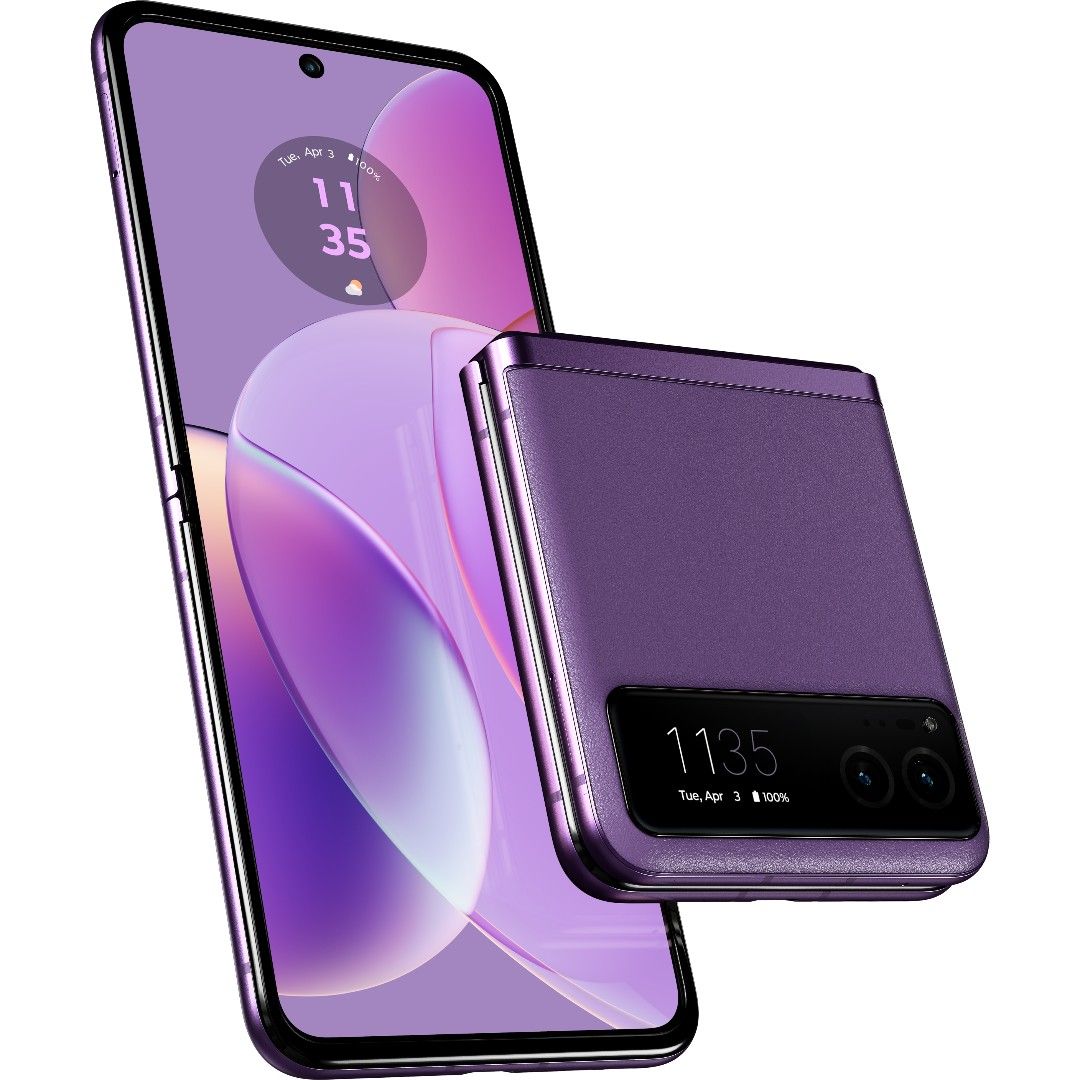
Motorola Razr (2023)
Everyone gets a flip phone
Nobody expected Motorola to be the manufacturer to bring high-end foldables into the midrange mainstream, but here we are. Exceptional build quality, impressive performance, and effective software highlight a smart flip phone that doesn’t really have any competitors at its price.
- Premium design
- Great main display
- Easy-to-use software
- Tiny cover display
- Average cameras
- Only available in one configuration
The lesser of Motorola’s 2023 foldables finally dares to bring flip phones into the affordable category, now seeing regular discounts to just $500 from multiple retailers. This low price might lead you to expect some major trade-offs, but we remain pleasantly surprised at how this moderately priced phone performs in a lot of ways.
The build quality is, quite simply, fantastic. It’s every bit as durable-feeling and comfortable to use as its more expensive Motorola alternative, including the hinge we loved so much on the Razr+. Our only major design quibble on either is the middling water resistance, although the overall IP52 rating is actually better than some competitors.
It’s not exactly slow, but the relatively old Snapdragon 7 Gen 1 doesn’t deliver the same kind of snappy experience you’ll get from a true flagship. The other main trade-off is the tiny outer display, which isn’t good for much outside of a clock and hard-to-see notifications. The inner display’s fantastic, though, especially given the price. Even the cameras satisfy, but don’t expect to get the same high-end experience you’d find on more expensive phones, whether they fold or not.
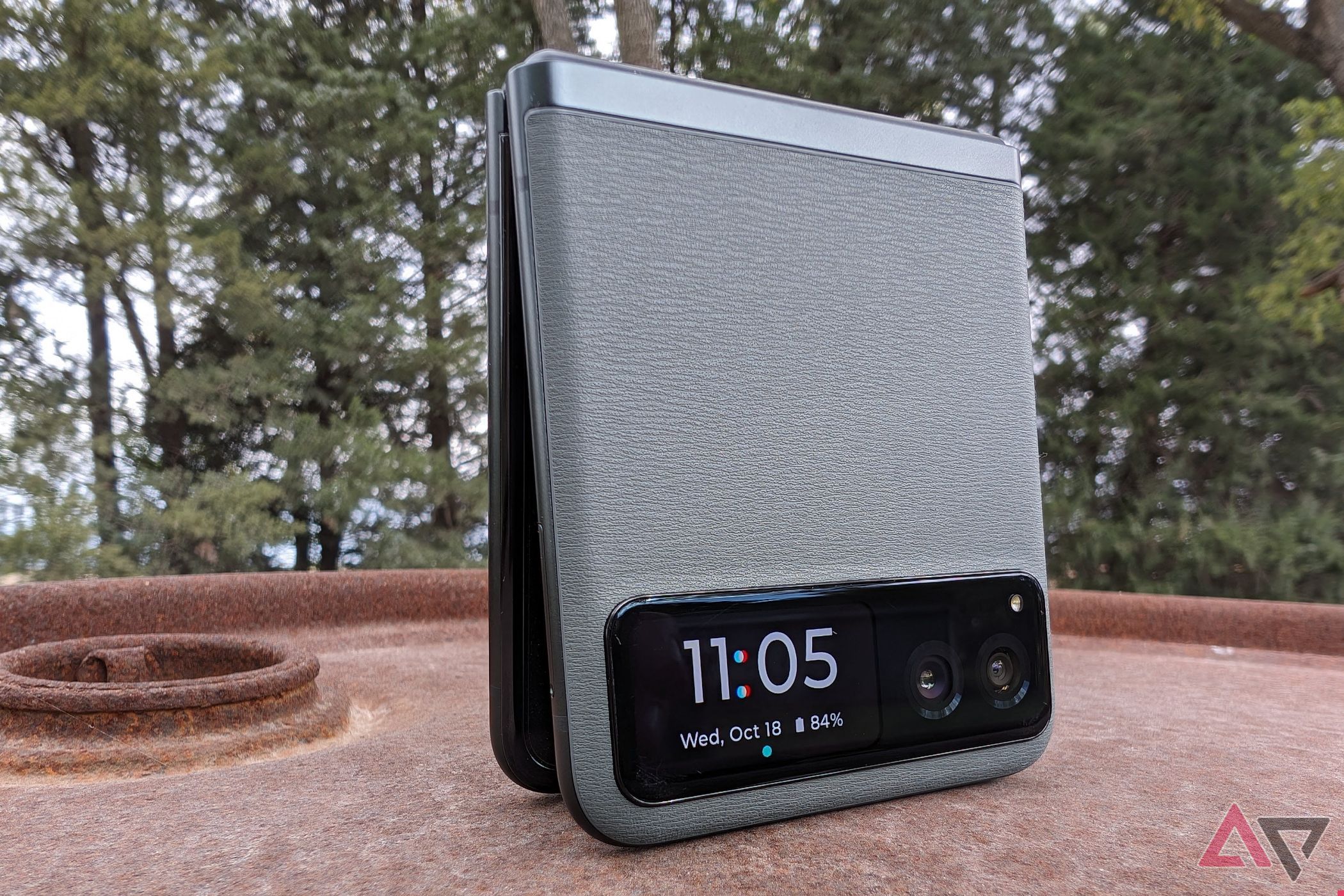
Motorola Razr (2023) review: Better than it should be
It’s not the flashiest or most powerful, but this clamshell foldable is great for the space
Overall, the 2023 Razr makes waves not because it’s the best phone ever, but because it’s a great foldable that a lot more people can afford. And despite its various drawbacks, it does look and feel like a high-end device.
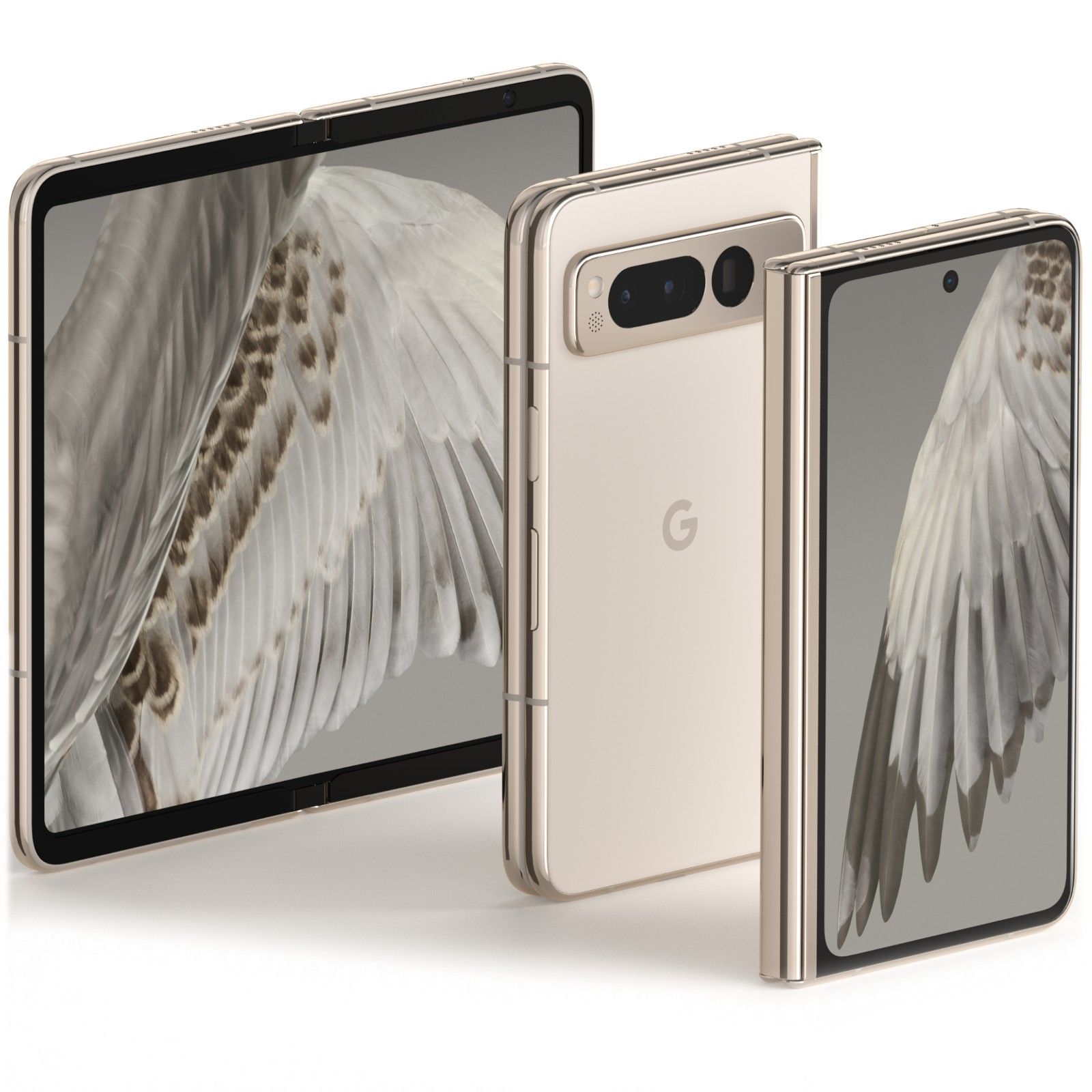
Google Pixel Fold
Literally, a Pixel that folds
The Pixel experience is one like no other. If you know and love the Pixel slab phones and want something similar on a folding tablet with blazing-fast 5G connectivity, look to the Pixel Fold. It does fall short in some areas, but diehard Pixel lovers might not care.
- Book-like hinge
- Folds flat and relatively thin
- Best camera on a foldable
- Inner screen quality leaves something to be desired
- Some odd software issues
- Mixed battery life and thermal performance
It’s far from a perfect device, but the Google Pixel Fold is the only foldable to get if you’re after the true Pixel experience on a tablet-style phone. Its wider aspect ratio makes the outer display more usable than most, and the inner display more tablet-y than any of the competition. Unsurprisingly, it also boasts excellent camera performance, the one area where it really stands out from the crowd.
The catch is that it does suffer from the quirks and drawbacks that are unsurprising from a first-gen Google device. The screen isn’t quite as bold or beautiful as the Pixel slab phones’, and the battery life is just OK. Then there’s the software experience, which seemed wholly under-baked at launch and has only improved moderately since.
The biggest problem has to do with apps. Google chose to prevent third-party apps from filling the entire screen unless they’re enhanced by developers, which means lots of apps fail to use up the available screen real estate.
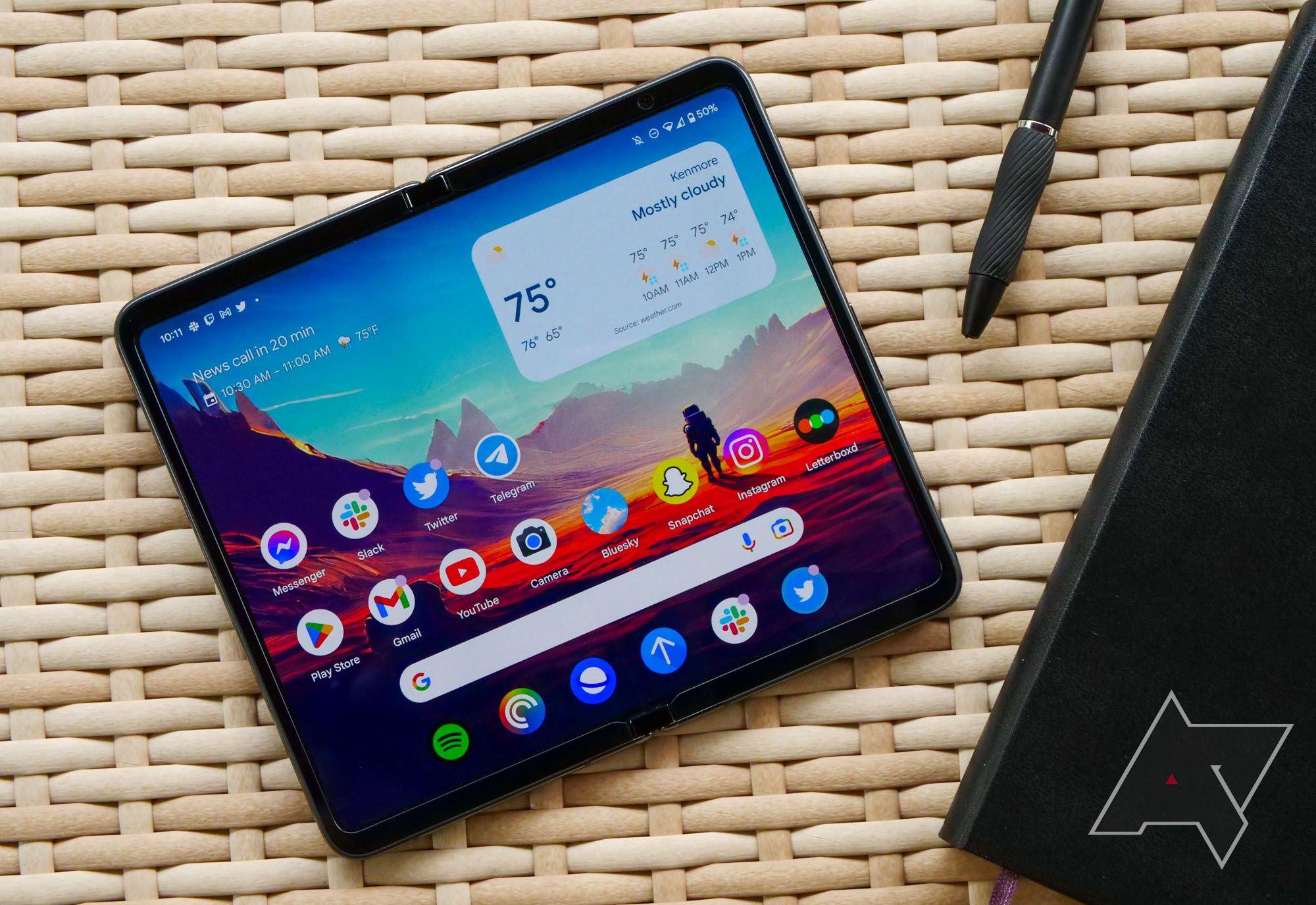
Google Pixel Fold review: An $1,800 rough draft
Google’s first foldable fails to live up to its full potential
The Pixel Fold more than makes up for that in the camera department, though. There’s a lot to love about how this phone takes photos, and it’s by far the best camera you’ll find on a foldable. Although, it’s probably better to wait for a few months because the upcoming Pixel Fold 2 is certainly going to improve upon almost every aspect of Google’s foldable experience. That being said, the discounted Pixel Fold is still a solid alternative to what Samsung is doing, especially if you don’t care for One UI.
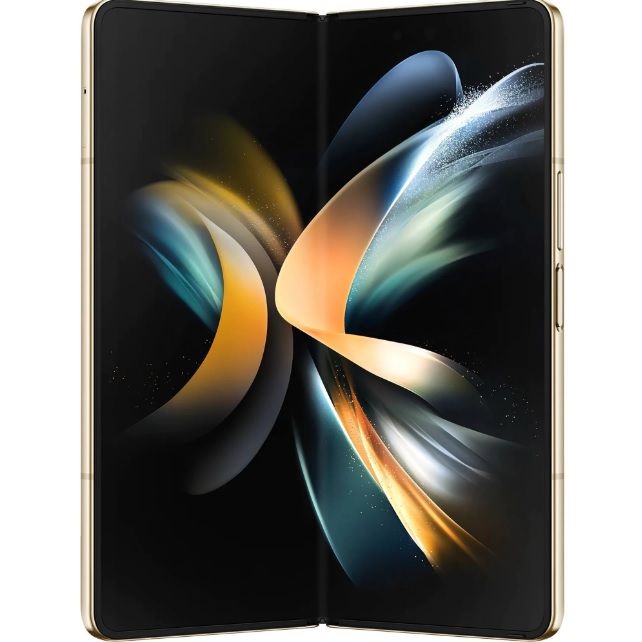
Samsung Galaxy Z Fold 4
Still excellent even after two years
The Galaxy Z Fold 4 is still an excellent folding phone with plenty of power thanks to a Snapdragon 8+ Gen 1 and 12GB of RAM. The center screen is a large 7.6-inch 120Hz OLED with S Pen support making this phone perfect for getting work done without opening a laptop.
- Gorgeous 7.6-inch internal 120Hz OLED
- Upgraded cameras over the previous generation
- Support for S Pen input
- Wired charging speed tops out at 25W
- Doesn’t fold as flat at the latest model
- Still very expensive
Samsung’s Galaxy Z Fold 5 has upgraded most aspects of the Z Fold 4 from two years ago, but the older model is still an excellent folder for those looking to upgrade without spending new phone prices. Given the minimal improvements to the new one, the Fold 4 is still a worthy contender. You can even pick up an S Pen for fine inputs or note-taking.
We weren’t wowed by the battery life, but it’s definitely passable. In what’s a common refrain, the moderate battery performance isn’t helped by the 25W charging limitation, although 15W wireless charging does add some convenience. And the cameras, while not on the level of the Galaxy S series, do work well, despite suffering from the same saturation and motion blur issues we’re familiar with from the Korean smartphone giant.
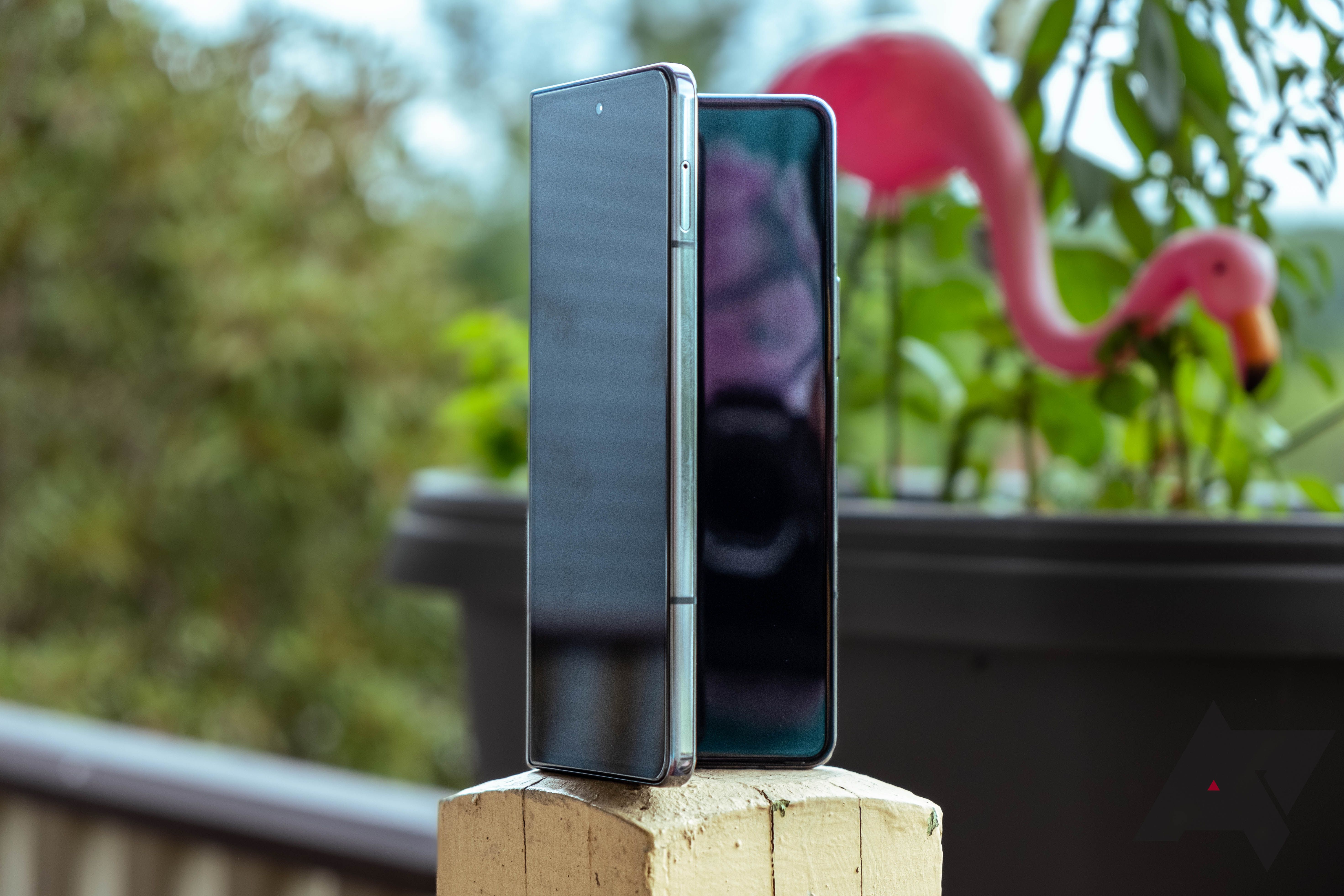
Samsung Galaxy Z Fold 4 review: The phone of the future
Big screen, big price tag, big multitasking energy
Naturally, Samsung’s One UI interface still gets great marks. If you’re after that user-friendly experience and don’t want to splash out on the latest device, the Z Fold 4 is a solid choice.
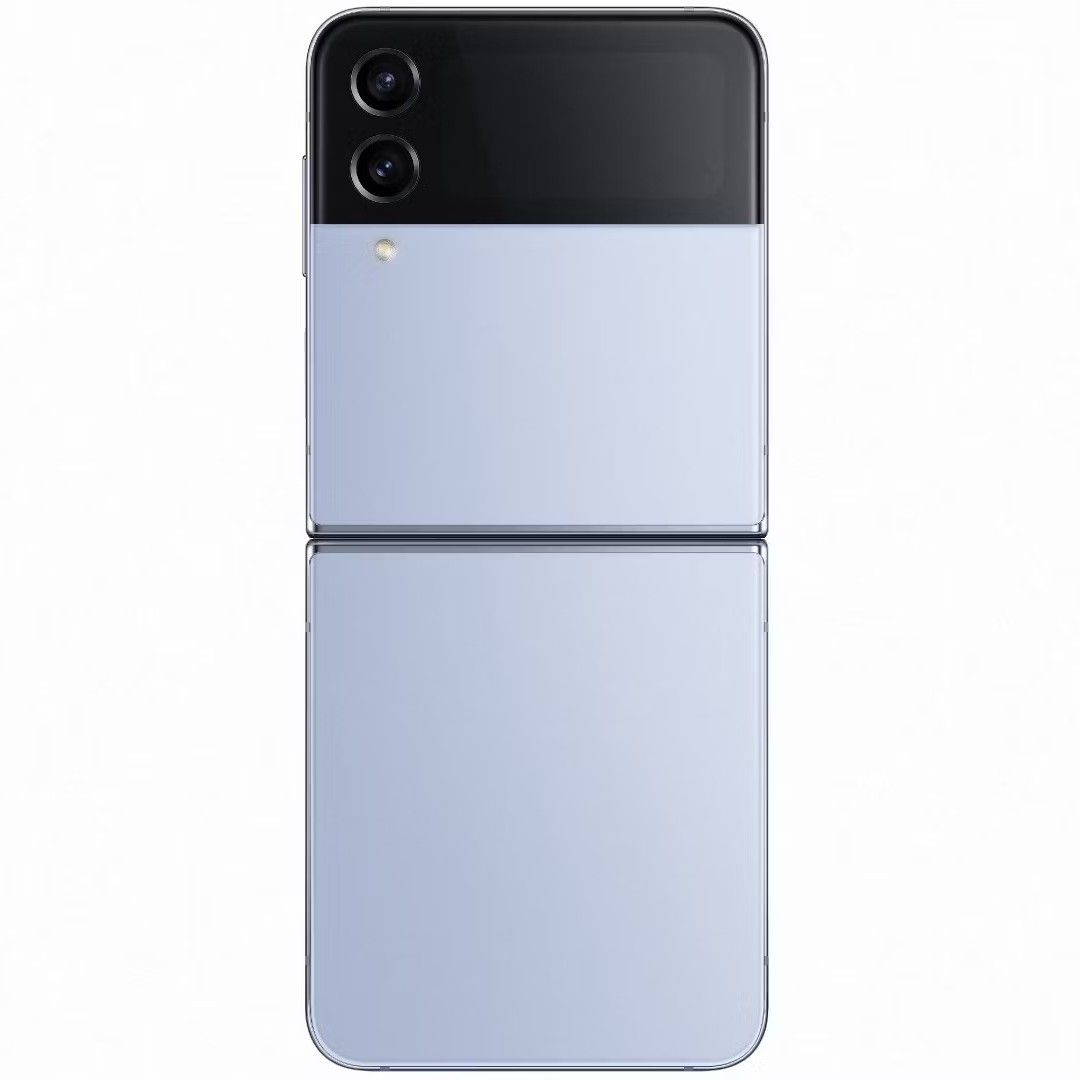
Samsung Galaxy Z Flip 4
Still a fantastic flip phone
Despite its smaller external display, the Galaxy Flip 4 is still a sleek and convenient clamshell folding phone. It’s got plenty of power for modern tasks with the Snapdragon 8+ Gen 1 under the hood and years of updates promised.
- Sleek and durable
- Distinctive design
- Incredible value
- Small cover display
- So-so cameras
Despite being from two years ago, the Z Flip 4 remains a great device. It performs close to as well as one of today’s great flagships and boasts Samsung’s venerated OneUI software suite. But the potential value is the real reason to consider this one.
Buying a used, refurbished, or renewed smartphone can be a dicey game, and we don’t typically recommend it for most people. But the difference here is that you can pick up a secondhand Z Flip 4 for right around $300 from some trusted retailers. That’s less than even today’s best budget phones, making it an excellent investment for people who don’t want to spend much, but do want some of the fanciest (relatively) new technology.
It does have its drawbacks, with battery life at the forefront of them. Its hinge also doesn’t feel as durable or premium as most newer flip phones, but if you’re new to this form factor, you won’t notice. The cameras aren’t that great, either, but they are at least as good as other $300 phones can offer.
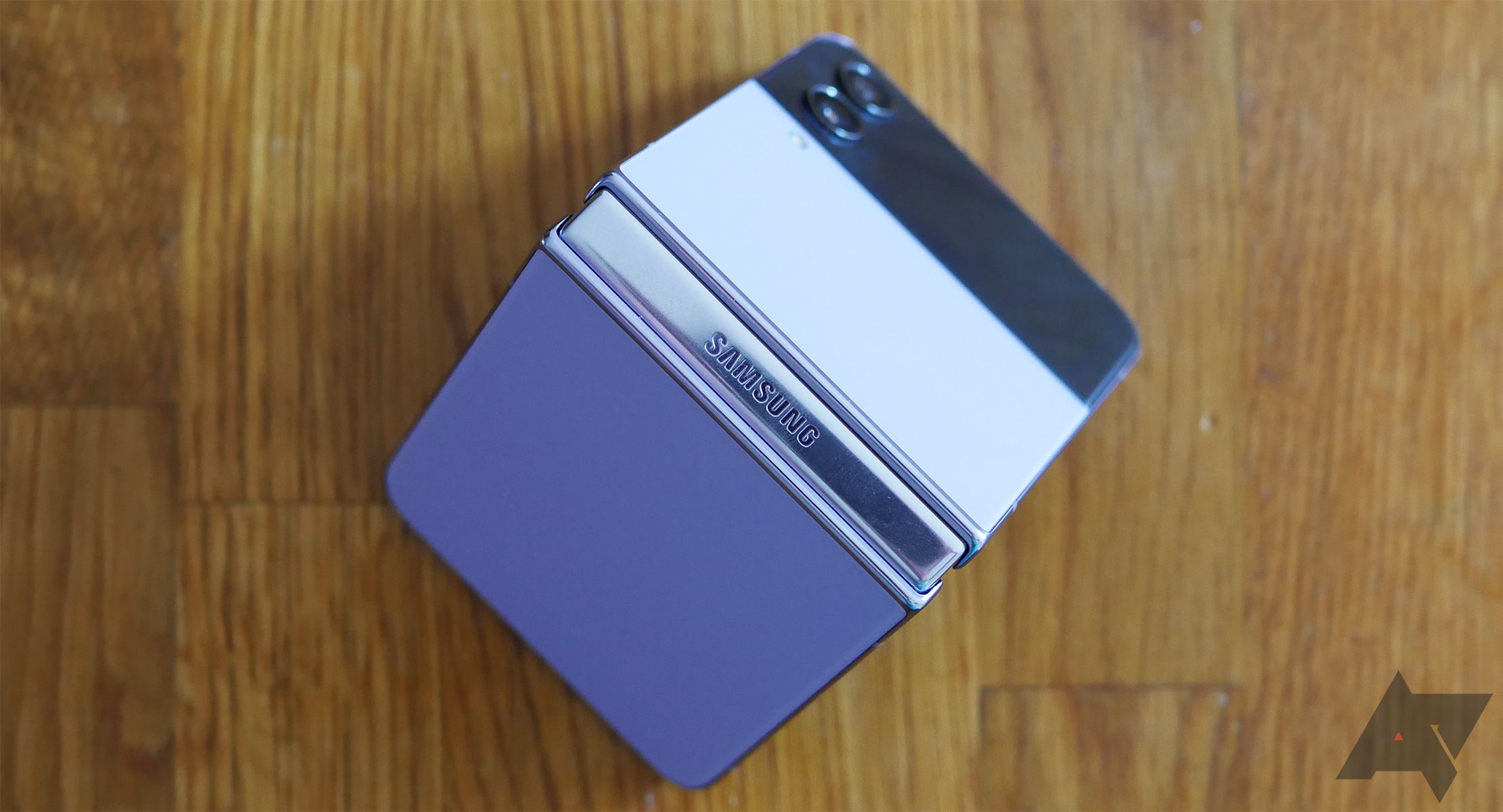
Samsung Galaxy Z Flip 4 review: How I learned to stop worrying and love foldables
Stop hemming and hawing, and just buy your first foldable, already
Altogether, the last-gen Z Flip does make some big trade-offs compared to newer models from Samsung and others. But if you’re on a tight budget, have never had a foldable before, and want to see if this novel form factor is really as cool and useful as everyone says, there’s no better option. You’ll even have the peace of mind of reasonable secondhand quality if you buy from a trusted vendor such as Amazon.
What good foldables exist outside the U.S. market?
A few international models show tons of promise, and it’s a bit unfortunate the manufacturers opted not to release them stateside. If you’re vigilant, you can actually find them available for import, but you’ll want to ensure the ROM version you invest in works properly in the U.S. That often means looking for a Singaporean version, but in any case, you’ll want to double-check that any imported phones support the important LTE and 5G bands for use in the States. If that and the overall import process are a little daunting, you should probably stick to a U.S. phone, but it’s still worth knowing what’s out there.
Honor Magic V2
From a design standpoint, it’s hard to top the Honor Magic V2. It’s as slim as a tablet-style foldable gets, and offers great performance thanks to the Snapdragon 8 Gen 2 and 16GB of RAM. The battery life also beats most others in its form factor, and the charging speed is right there with the OnePlus Open. We weren’t super impressed with the software implementation, though, and it’s quite the costly handset. Nonetheless, this is a fantastic device, and it would be nice if its successor sees a U.S. launch.
Xiaomi Mi Mix Fold 3
Barely present in the U.S. market, Xiaomi has a history of releasing electronics we wish could make it to this side of the pond. The Mi Mix Fold 3 is one such device. Like the Honor Magic V2, it’s shockingly thin, and feels as futuristic as any phone we’ve held. It’s not even terribly expensive, as far as flagship phones go. But this might be one of the hardest international models to find, as U.S.-compatible versions are vanishingly difficult to get your hands on.
Oppo Find N3 Flip
Given that its tablet-style sibling made it stateside in the form of the OnePlus Open, it’s a bit surprising the Find N3 Flip never got this far. The inner screen’s bright and colorful, and the outer one’s bigger than the Razr and Flip 4’s, although smaller and less useful than the Razr+ and Flip 5’s. Performance is pretty good, too, although the MediaTek Dimensity 9200 doesn’t live up the standards Qualcomm has set. If you’re not a fan of what Motorola and Samsung offer, it’s a decent competitor if you’re willing to import.
Picking the right foldable
For years, buying a foldable or flip phone in the United States meant a choice between Samsung’s tablet-like Galaxy Z Fold or its fun Z Flip. While Motorola’s early Razr 5G raised our hopes that we’d have some exciting alternatives for flip phones, it took until 2023 before it made its big comeback with the Motorola Razr+ and Razr (2023) — two flip phones that definitely give the Galaxy Z Flip 5 a run for its money.
However, the market has heated up nicely among tablet foldables as well, with Google and OnePlus dropping some serious competition to Samsung’s book-style foldable. While the Galaxy Z Fold 5 still has its advantages, it’s no longer the de facto leader in this category, and there are some very compelling reasons to choose an entry from Google or OnePlus instead.
Lastly, you no longer have to spend a bundle to get a foldable phone. Motorola’s Razr (2023) is a new flip phone that comes in around $500, given the common discounts and cuts mostly the right corners to get there.
Just remember that Samsung, Google, and OnePlus will release their next-generation models in the second half of 2024, likely leading to better deals on older models.

Motorola Razr+ (2023)
Motorola’s foldable returns in style
The Motorola Razr+ puts the fun back into a smartphone. With a 3.6″ 1:1 display on the outside of the device, it has never been easier to manage notifications, texts, navigation, and so much more. And when you unfold the phone, a more standard 6.9″ display is revealed. The Razr+ is a surprising rebound after the first couple of generations failed to get any traction.

OnePlus Open
An impressive first attempt
Although the Open is technically OnePlus’s first foldable phone, it gives the competition a run for its money with an impressive debut. It boasts excellent build quality with the internals expected of a 2023 flagship phone, plus it offers innovative software features. And unlike its rivals, the OnePlus Open includes a charger and a case in the box.




